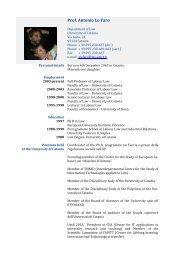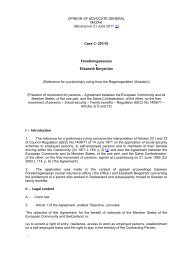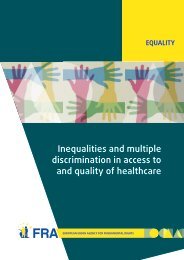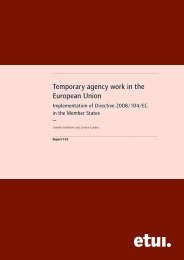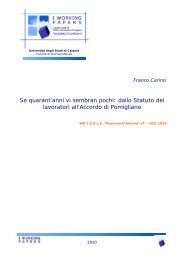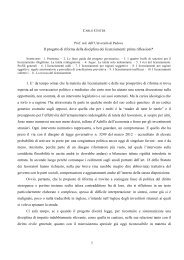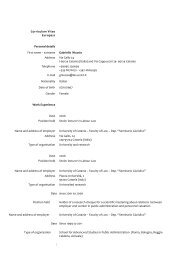Study on non-legislative initiatives for companies to promote gender ...
Study on non-legislative initiatives for companies to promote gender ...
Study on non-legislative initiatives for companies to promote gender ...
Create successful ePaper yourself
Turn your PDF publications into a flip-book with our unique Google optimized e-Paper software.
68 Gender equality <strong>initiatives</strong><br />
area 3 – <strong>gender</strong> equality<br />
• assure equal pay and equal definiti<strong>on</strong>s of functi<strong>on</strong>s;<br />
• adapt the working c<strong>on</strong>diti<strong>on</strong>s <strong>to</strong> ensure work-life balance<br />
Engaging in the labelling process implies an effective and c<strong>on</strong>tinuing investment in<strong>to</strong> all<br />
these comp<strong>on</strong>ents. A success fac<strong>to</strong>r of the Belgian Equality Diversity Label is that the<br />
process is carried out in several phases that allow <strong>for</strong> c<strong>on</strong>cise planning and adaptati<strong>on</strong>s<br />
within the course of acti<strong>on</strong> where necessary.<br />
Labels with special focus<br />
One example <strong>for</strong> a label focussing <strong>on</strong> <strong>on</strong>e area identified as being crucial with regard <strong>to</strong><br />
<strong>gender</strong> equality 25 has been launched in Switzerland 26 and is currently in the pilot phase<br />
(until the end of 2009). It aims <strong>to</strong> be applicable <strong>to</strong> any organisati<strong>on</strong> around the world.<br />
“equal salary - Zertifikati<strong>on</strong> der Lohngleichheit v<strong>on</strong> Frauen und Männern”<br />
(Certificati<strong>on</strong> of wage equality between women and men) provides an easy, practical<br />
and recognised analytical <strong>to</strong>ol, which allows <strong>companies</strong> <strong>to</strong> <strong>promote</strong> their fair wage<br />
policy while encouraging them <strong>to</strong> test their equal compensati<strong>on</strong> policies in <strong>to</strong>tal c<strong>on</strong>fidentiality.<br />
It is addressed <strong>to</strong> <strong>companies</strong> and organisati<strong>on</strong>s with a minimum of 50<br />
employees and a minimum of 10 women.<br />
The certificati<strong>on</strong> process is divided in two phases:<br />
• Phase I: Salary evaluati<strong>on</strong> by OUE (Observa<strong>to</strong>ire universitaire de l’emploi) –<br />
University of Geneva<br />
A statistical analysis of the company’s salary data is c<strong>on</strong>ducted in order <strong>to</strong><br />
measure whether the wage policy of the company is fair and equitable <strong>on</strong> the<br />
basis of a so-called wage equati<strong>on</strong>. The wage level of each employee can be<br />
statistically explained taking in<strong>to</strong> account all those specific characteristics of the<br />
employee that are relevant in the company’s salary policy such as, <strong>for</strong> example,<br />
educati<strong>on</strong>, experience, seniority, functi<strong>on</strong> etc. If there is still wage discriminati<strong>on</strong><br />
despite taking in all the relevant variables, it can be c<strong>on</strong>cluded that there is a<br />
wage discriminati<strong>on</strong> based <strong>on</strong> sex.<br />
Subsequently, an “in-depth evaluati<strong>on</strong>” provides the company with specific<br />
suggesti<strong>on</strong>s <strong>to</strong> improve its salary structure.<br />
Once the analysis is d<strong>on</strong>e, OUE submits a report <strong>on</strong> the results. If the difference<br />
between the salary of men and women is smaller than 5 %, the certificati<strong>on</strong><br />
process can proceed. If not, the company can improve its salary policy in order<br />
<strong>to</strong> apply <strong>for</strong> certificati<strong>on</strong> at a later stage.<br />
25<br />
26<br />
See e.g. European Commissi<strong>on</strong> (2007): Tackling the pay gap between women and men. COM (2007)<br />
424<br />
Switzerland is not within the scope of this study but this initiative seemed <strong>to</strong> be of high relevance.<br />
There<strong>for</strong>e, the initiative was analysed in-depth as a case study, but is not included in the list of<br />
<strong>initiatives</strong> in annex 1.




